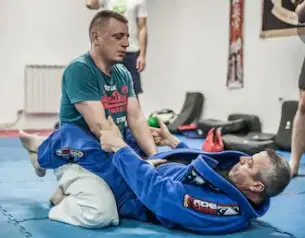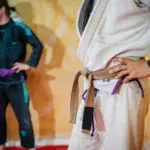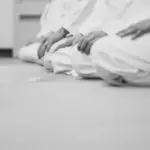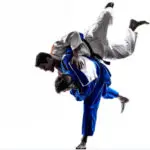Ever wonder what the fundamentals are in Brazilian Jiu-Jitsu? We all jump into our first class and start learning techniques, some core values are taught throughout, but you may not hear often what the fundamentals are. I looked into it and I cover it in this article!
Brazilian Jiu-Jitsu breaks down into a 4 step system: take your opponent to the ground, pass the legs. work your way through the hierarchy of pins, and attack with a submission. There are three fundamental hierarchical positions in BJJ: standing, top ground, and bottom ground. Each one of those positions has further fundamentals objectives (see the table below) and techniques associated with them.
| Standing | Ground Top | Ground Bottom |
| Stance | Open/closed guard | Pin escapes |
| Motion | Passing open guard | Guard retention |
| Grip | Passing half-guard | Guard sweeps |
| Off-balance | Pin maintenace/transitions | Half-guard sweeps |
| Transition to the ground | Turtle breakdown | Turtle escapes |

What Are The Fundamentals?
The fundamentals of Brazilian Jiu-Jitsu is to bring a fight to the ground, control your opponent using pins, and attack with a submission. If you find yourself in the bottom position, the goal is to create space by bridging and shrimping, maintain distance with frames and wedges. and finally, use leverages to flip your opponent over to gain a dominant position.
Core techniques that are utilized throughout BJJ are:
- Bridging
- Shrimping
- Framing
- Wedging
- Leveraging
- Basing
- Maintaining posture
- Pressuring
Importance Of Fundamentals
Fundamentals in Jiu-Jitsu translate into every position, technique, and concept. There are always new techniques and meta’s coming in the sport, but the fundamentals are the underlying basics that won’t change.
Brazilian Jiu-Jitsu will always concentrate on bringing your opponent to the ground; it is a ground grappling martial art and sport. The reason BJJ takes the fight to the ground is that it takes power away from your opponent and the chaotic nature standing can present.
The top and bottom ground positions are fundamental because these are the two available options on the ground. Passing to a more dominant position will be essential to beating your opponent and escaping dominant positions will be necessary for survival.
New techniques can come and go, but these core concepts will remain, which is why they are fundamental.
Many techniques will show how the fundamentals work. The scissor sweep from guard shows the importance of grips, creating space, off-balancing, and leverages to sweep (knock over) your opponent.
The 4-Step System Of Brazilian Jiu-Jitsu
The 4 step system of Jiu-Jitsu was vocalized by John Danaher which entails: take your opponent to the ground, pass the legs. work your way through the hierarchy of pins, and attack with a submission. This 4 step system translates into 3 overall positions: standing, ground top, and ground bottom.
The first step takes the opponent to the ground to avoid the volatile nature stand up fight presents. Taking the fight to the ground also removed the amount of power your opponent can produce with their arms and legs.

Passing the legs removes the dangers they impose. The legs can kick and sweep you over so that you are on the bottom ground position.
Once the legs are passed, maintaining a dominant position must be achieved. Side control, knee-on-belly, mount, and back mount are the core top positions. They offer the ability to control your opponent while offering you the ability to strike and set up a submission with little risk.
Fundamental Positions
There are three fundamental positions in Jiu-Jitsu: standing, ground top, and ground bottom. The first objective is to win the standing battle allowing you to bring the fight to the ground. Next is to transition through the hierarchy of positions to control the opponent, or if you find yourself on the bottom escape to transition to the top position.
Want to learn more about the ground position in Brazilian Jiu-Jitsu? I made a post explaining them along with the points associated with them if you’re interested in competing!
Standing
The standing position in BJJ requires a solid, stable base so that you can establish grips that can off-balance your opponent. Using motion will allow you to move around your opponent to get a better position to grip them. Causing your opponent to be forcefully moved will help off-balance them. Finally, the transition to the ground using a takedown technique.
Here are 5 takedowns that are used in the standing position:
- Ouchi Gari
- Arm drag with Inside Trip
- Single-leg takedown
- Double-leg takedown
- Ankle Pick
I feel as though Chris Haueter describes the fundamentals of standing positions very well. The video below has a good demonstration of basic grips and using motion to off-balance your opponent.
Ground Top
The top position in Brazilian Jiu-Jitsu starts by passing the legs and/or getting out of closed/open guard. Next is establishing a dominant position and maintaining it by preventing your opponent from escaping. Transitioning to more dominant positions will net you points in sport Jiu-Jitsu which is based on the threat your opponent poses to you in a fight.
There are many aspects to safely escaping the guard and passing the legs, especially in a fight where the opponent can up-kick you from the ground. Learning how to maintain posture and a stable base so that you can set up your escape are important skills to learn to safely progress your position.
Common top techniques used in Brazilian Jiu-Jitsu:
- Knee slide
- Half-guard pressure pass
- Toreando pass
- Kimura
- Arm-triangle
Ground Bottom
The bottom ground position in Brazilian Jiu-Jitsu focuses on escaping dominant positions from your opponent, retaining guard, and sweeping your opponent to gain a top dominant position.
Escaping from your opponent’s dominant top position (mount, side mount, knee-on-belly, etc..) is important because it puts you in a vulnerable position that can lead to you getting submit (or in a fight punched).
Retaining guard is important because the guard can be a safe(er) place in the bottom position as it allows for many attacking techniques to be used. From sweeps to submissions, the guard allows you to set up those attacks if you’re controlling and retaining it.
Bottom guard attacks and sweeps that can be used are:
- Triangle
- Armbar
- Collar choke
- Scissor sweep
- Pendulum sweep
- Hip bump
Conclusion
The fundamentals in Brazilian Jiu-Jitsu are not a set of techniques or moves. They are the overlying concepts in Jiu-Jitsu: bring the fight to the ground, pass the legs, control dominant positions, and attack with a submission.
There are 3 fundamental positions in BJJ: standing, top ground, bottom ground. Each position uses different grips, off-balancing, leverages, transitions, frames, and wedges. Using those introduce many different techniques that utilize them to allow you to transition through positions and eventually attack.


